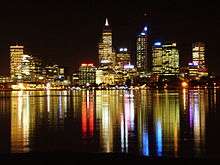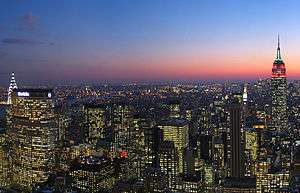Metropolitan area
A metropolitan area, sometimes referred to as a metro area or commuter belt, is a region consisting of a densely populated urban core and its less-populated surrounding territories, sharing industry, infrastructure, and housing.[1] A metro area usually comprises multiple jurisdictions and municipalities: neighborhoods, townships, boroughs, cities, towns, exurbs, suburbs, counties, districts, states, and even nations like the eurodistricts. As social, economic and political institutions have changed, metropolitan areas have become key economic and political regions.[2] Metropolitan areas include one or more urban areas, as well as satellite cities, towns and intervening rural areas that are socio-economically tied to the urban core, typically measured by commuting patterns.[3]
For urban centres outside metropolitan areas, that generate a similar attraction at smaller scale for their region, the concept of the regiopolis and respectively regiopolitan area or regio was introduced by German professors in 2006.[4]
General definition
A metropolitan area combines an urban agglomeration (the contiguous, built-up area) with zones not necessarily urban in character, but closely bound to the center by employment or other commerce. These outlying zones are sometimes known as a commuter belt, and may extend well beyond the urban zone, to other political entities. For example, El Monte, California is considered part of the Los Angeles metro area in the United States.
In practice, the parameters of metropolitan areas, in both official and unofficial usage, are not consistent. Sometimes they are little different from an urban area, and in other cases they cover broad regions that have little relation to a single urban settlement; comparative statistics for metropolitan area should take this into account. Population figures given for one metro area can vary by millions.
There has been no significant change in the basic concept of metropolitan areas since its adoption in 1950,[5] although significant changes in geographic distributions have occurred since then, and more are expected.[6] Because of the fluidity of the term "metropolitan statistical area," the term used colloquially is more often "metro service area," "metro area," or "MSA" taken to include not only a city, but also surrounding suburban, exurban and sometimes rural areas, all which it is presumed to influence.
A polycentric metropolitan area is one not connected by continuous development or conurbation, which requires urban contiguity. In defining a metropolitan area, it is sufficient that a city or cities form a nucleus that other areas have a high degree of integration with.
Unique country-specific official definitions
Algeria
Algeria has two major metropolitan areas: Algiers and Oran. Algiers is the capital with more than 4 million inhabitants and Oran is the commercial and industrial city with more than 1.4 million inhabitants.[7]
Australia

The Australian Bureau of Statistics defines 'statistical divisions' as areas under the unifying influence of one or more major towns or a major city.[8] Each of the state and territory capital cities as well as the national capital, Canberra, forms its own statistical division, and the population of the statistical division is the figure most often quoted for that city's population. However, this definition has largely become obsolete with the conurbation of several statistical divisions into a larger metropolitan areas. For example, the City of Brisbane, the capital city of Queensland, has long since become contiguous with the surrounding cities of Ipswich, Logan City, Redland City, Redcliffe, Pine Rivers, Caboolture and the Gold Coast. This conurbation is common to all the major metropolitan areas of Australia, which include all the capital cities and many major regional centres such as the Gold Coast, Newcastle, Wollongong, Geelong, Townsville, Cairns and Toowoomba.
Brazil
.jpg)
In Brazil, metropolitan areas are called 'metropolitan regions'. Each State defines its own legislation for the creation, definition and organization of a metropolitan region. The creation of a metropolitan region is not intended for any statistical purpose, although the Brazilian Institute of Geography and Statistics uses them in its reports. Their main purpose is to allow for a better management of public policies of common interest to all cities involved. They don't have political, electoral or jurisdictional power whatsoever, so citizens living in a metropolitan region do not elect representatives for them. There are currently 52 metropolitan regions, distributed in all major regions of the country, the largest of them being the metropolitan area of São Paulo with over 21,242,900 inhabitants, making it the largest metropolitan area in the southern hemisphere, and the 7th largest in the world.
Canada

Statistics Canada defines a census metropolitan area (CMA) as an area consisting of one or more adjacent municipalities situated around a major urban core. To form a CMA, the metropolitan area must have a population of at least 100,000, at least half within the urban core. To be included in the CMA, adjacent municipalities must have a high degree of integration with the core, as measured by commuter flows derived from census data.[9] As of the Canada 2011 Census, there were 33 CMAs in Canada, including six with a population over one million—Toronto, Montreal, Vancouver, Ottawa, Calgary and Edmonton.[10]
China
Denmark
In Denmark the only metropolitan area is Greater Copenhagen,[11] consisting of the Capital Region of Denmark along with the neighboring regions Region Zealand and Skåne County (Sweden). Greater Copenhagen has an approximate population of 1.25 million people.[12][13] This area is the most densely populated area in the Nordic Region.[14] The definition broadly overlaps with that of the Øresund Region.
Egypt
In Egypt, there is officially a region called Greater Cairo, which includes the capital and its province as well as surrounding cities. Alexandria's urban area is another metropolitan area, but not considered officially as such.
Pakistan
In Pakistan, there is officially a region called Greater Karachi and Lahore, which includes the capital city Islamabad and its province as well as surrounding cities. Faislabad's urban area is another metropolitan area, but not considered officially as such.
European Union
The European Union's statistical agency, Eurostat, has created a concept named Larger Urban Zone (LUZ). The LUZ represents an attempt at a harmonised definition of the metropolitan area, and the goal was to have an area from a significant share of the resident commute into the city, a concept known as the "functional urban region".[15]
Belgium
Belgium has five metropolitan areas, Brussels, Antwerp, Liège, Ghent and Charleroi
Ireland
The Republic of Ireland has two metropolitan areas, Dublin and Cork.
France
France's national statistics institute, the INSEE, names an urban core and its surrounding area of commuter influence an aire urbaine (official translation: "urban area"[16]). This statistical method applies to agglomerations of all sizes, but the INSEE sometimes uses the term aire métropolitaine (metropolitan area) to refer to France's largest aires urbaines.
The top ten metropolitan cities based on 2012 Census population are Paris, Lyon, Marseille, Toulouse, Lille, Bordeaux, Nice, Nantes, Strasbourg and Rennes.
Greece
Greece has two metropolitan areas, Athens Metropolitan Area and Thessaloniki Metropolitan Area.
India

In India, a metropolitan city is defined as, one having a population of 1 million and above.[17] As of 2011 census of India, there are 46 metropolitan cities in India and the top ten are, Mumbai, Delhi, Kolkata, Chennai, Bengaluru, Hyderabad, Ahmedabad, Surat, Pune, Patna and Jaipur.[18] Residents of these cities are also entitled to a higher house rent allowance.[19]
Indonesia
Indonesia has five officially recognised metropolitan areas – Bandung, Jakarta, Medan, Surabaya and Makassar. Jakarta is Indonesia's capital and largest city with approximately 28 million metropolitan inhabitants.[20] Outside this 5 metropolitan region, there are more than 15 cities with metro population more than 1 million.
Israel
In Israel there are four recognized metropolitan areas: Tel Aviv, Jerusalem, Haifa and Beersheba. Tel Aviv Metropolitan Area in late 2005 numbered about three million inhabitants. This is a center of metropolitan employment and business in Israel. Today, some argue that the Tel Aviv metropolitan area—Gush Dan, will be deployed in future from Hadera to Gedera (for all "rings"—inner, middle and outer). Nazareth is also a developing metropolitan area, somewhat in the scale of Beersheba. By most definitions a big part of Jerusalem's metropolitan area is in the West Bank and so is some of Tel Aviv's.
Japan
The term toshiken (都市圏, metropolitan area in Japanese) refers to a metropolitan area in Japan. The Greater Tokyo Area is a major metropolitan area in the nation, consisting of the Kantō region of Japan, including the Tokyo Metropolis, as well as Yamanashi Prefecture.
Korea
In Korea, the term of metropolitan area is gwang-yeoksi (광역시, officially translated in Korean) and Teukbyeolsi (특별시).
Philippines
Metro Manila is the largest conurbation or urban agglomeration in the Philippines, and its official metropolitan area is composed of the city of Manila plus 15 neighboring cities and a municipality. Other metropolitan areas are centered on the cities of Angeles, Bacolod, Baguio, Batangas, Cagayan de Oro, Cebu, Dagupan, Davao, Iloilo, Naga, Olongapo.
Spain
Spain has a few large metropolitan areas, Madrid, Barcelona, Bilbao, Valencia, Seville, Málaga, Zaragoza, Mallorca, A Coruña. The largest is Madrid, with about 6 million inhabitants.
Tunisia
Tunisia has 3 major metropolitan areas: Tunis, Sfax and Sousse. The largest being Tunis with 2.7 million inhabitants.[21]
Turkey
The word metropolitan describes a major city in Turkey like Istanbul, a city that is dominant to others both financially and socially.[23] There are 16 officially defined "state metropolitan areas" in Turkey, for governing purposes.[24] More than ten of these metropolitan areas are populated with more than one million people: İstanbul, Ankara, İzmir, Bursa, Adana, Gaziantep, Konya, Antalya, Samsun, Kayseri, Eskişehir and Mersin.
İstanbul-Kocaeli-Sakarya-Yalova-Bursa metropolitan areas, almost continuously inhabited, form one single megalopolitan area around the eastern part of Marmara Sea, with total population of almost 20 Million and with the combined economy of US$750 Billion. İstanbul Province itself has a population of 17 Million and an economy of almost US$500 Billion.
United Kingdom
There are currently (2011) 46 metropolitan areas in the United Kingdom with a populations in the range 150,000 to 25 million inhabitants, according to the European Union's ESPON project, with the following population distributions:
| Category | Populations - 2011 | Count |
|---|---|---|
| A | 12.8 - 25 million | 1 |
| B | 6.4 - 12.8 million | 0 |
| C | 3.2 - 6.4 million | 1 |
| D | 1.6 - 3.2 million | 3 |
| E | 0.8 - 1.6 million | 7 |
| F | 0.4 - 0.8 million | 9 |
| Gi | 0.2 - 0.4 million | 19 |
| Gii | =<0.2 million | 6 |
| Total | 46 | |
The largest is London Metropolitan Area with 14.0 million inhabitants; the next largest metropolitan area, Birmingham,
is a step change down with 3.7 million inhabitants.
United States

Most recently on February 28, 2013, the United States Office of Management and Budget defined 1,098 statistical areas for the metropolitan areas of the United States and Puerto Rico.[25] These 1,098 statistical areas comprise 929 Core Based Statistical Areas (CBSAs)[26] and 169 Combined Statistical Areas (CSAs).[27] The 929 Core Based Statistical Areas are divided into 388 Metropolitan Statistical Areas (MSAs – 381 for the U.S. and seven for Puerto Rico)[28] and 541 Micropolitan Statistical Areas (μSAs – 536 for the U.S. and five for Puerto Rico).[29] The 169 Combined Statistical Areas (166 for the U.S. and three for Puerto Rico) each comprise two or more adjacent Core Based Statistical Areas.
Vietnam
Vietnam's two metropolitan areas are the Hanoi Capital Region and Ho Chi Minh City Metropolitan Area.
Megalopolis

The concept of a "megalopolis" was first examined in detail by the Scottish geographer Patrick Geddes in his 1915 book Cities in Evolution. Geddes describes it as a "city-region", a chain of interlinked urban or metropolitan areas.
One prominent North American example of a megalopolis is the Northeast megalopolis, sometimes called the BosWash after the cities on either end: it consists of Boston; Providence, RI; Hartford, CT; Greater New York City; Philadelphia; Wilmington, DE; Baltimore; Washington, DC and their vicinities.[30] Two other prominent megalopolises in North America are as follows:
- In California and Baja California, Ventura County, Los Angeles County, Orange County, San Diego County, part of Riverside County, part of San Bernardino County, Tijuana Municipality, Rosarito Beach Municipality, Mexicali Municipality, and Tecate Municipality. There are hundreds of cities and towns in this megalopolis, with the largest ones being Los Angeles, Long Beach, Irvine, Anaheim, San Diego, and Tijuana.
- The bi-national Great Lakes Megalopolis consists of the group of North American metropolitan areas surrounding the Great Lakes region within the Midwestern United States, Southern Ontario, and parts of Pennsylvania, New York, and Quebec. The region extends from the Milwaukee–Chicago–Gary corridor to the Detroit–Toronto corridor, and includes Buffalo, Cincinnati, Cleveland, Columbus, Dayton, Erie, Grand Rapids, Indianapolis, Louisville, Ottawa, Rochester, and Toledo, reaching as far as Pittsburgh and St. Louis. The region had an estimated population of 54 million for the 2000 Census and is projected to reach about 65 million by 2025, although much of this area has remained rural, due in part to the decline of the Rust Belt.
The world's largest megalopolis is probably the Taiheiyō Belt (the Pacific megalopolis) of Japan on southeastern Honshu that consists of the metropolis of Tokyo, Kawasaki, Yokohama, Shizuoka, Hamamatsu, Nagoya, Kyoto, Osaka, Kobe, Okayama, Hiroshima, Kitakyushu, Fukuoka and their surrounding cities and towns. Major means of ground transportation in Japan such as its railroad network (for both passengers and freight), many expressways, and the "Shinkansen" bullet train are concentrated in this region, which also includes the northern shore of the Inland Sea of Japan. This is a highly industrialized part of Japan, and it is also the location of its most important seaports in Japan – such as at Yokohama, Osaka, Kobe, Hiroshima and Kure – and its most important international airports – such as at Tokyo and Osaka. The population of this megalopolis can be as high as 83 million people, depending on where one draws its boundaries.

Seoul National Capital Area is a megalopolis with a population of 24 million, which includes Seoul, Incheon, Suwon, Goyang and the rest of Gyeonggi-do and extends to some fraction of western Gangwon-do, and Chungcheong-do. Its area is over 10,000㎢ and about 11,745㎢, which is connected by ground transportation such as its railroad network, many expressways, and High-speed rail so-called "KTX".
Guangdong Province's Pearl River Delta is a megalopolis with a population of 48 million that extends from Hong Kong and Shenzhen to Guangzhou. Some projections assume that by 2030 up to 1 billion people will live in China's urban areas. Even rather conservative projections predict an urban population of up to 800 million people. In its most recent assessment, the UN Population Division estimated an urban population of 1 billion in 2050.[31]
Europe contains numerous large metropolitan areas, such as the Madrid metropolitan area in Spain (pop. 6.3 million), the Milan metropolitan area (pop. 8 million) in Italy, the Barcelona metropolitan area (pop. 5 million), the Randstad (pop. 7.1 million) in the Netherlands, the Upper Silesian metropolitan area (pop. 7 million) in Poland and the Czech Republic, and the Flemish Diamond (pop. 5.5 million) in Belgium. The largest are the London metropolitan area (pop. 13.6 million), Paris metropolitan area (pop. 12.2 million), and the Rhine-Ruhr metropolitan region (pop. 11.5 million) in Germany. However, it is generally considered only to contain one megalopolis, best known as the 'Blue Banana'. The concept was developed in 1989 by Frenchman Roger Brunet. Its precise extent is not universally agreed, but it typically stretches from London and the Thames estuary down the Rhine corridor including the likes of Brussels, Paris and the Rhine-Ruhr as far as Turin and Milan. Assessments of the total population range from 92 to 110 million, depending on the inclusion of the Parisian area which was most explicitly excluded by Brunet. It has been subject to criticism, particularly due to the discontinuity caused by the very low-population areas of the Alps and the North Sea; alternative models have also been suggested, such as the overlapping Golden Banana, and an emerging English megalopolis comprising most of southeastern England, the Midlands and parts of northern England. Indeed, using the criterion of population density, England as a whole already has a population density of 407 people per square kilometre,[32] which is higher than the United States Northeast megalopolis.
Africa's first megalopolis is situated in the urban portion of Gauteng Province in South Africa, comprising the conurbation of Johannesburg, and the metropolitan areas of Pretoria and the Vaal Triangle, otherwise known as the PWV.
Brazil has one megalopolis: the Rio de Janeiro—São Paulo Megalopolis, which includes parts of Minas Gerais, Rio de Janeiro and São Paulo states and has a population of over 45 million inhabitants. It spreads throughout much of the Southeast Region of the country, a conurbation that brings together more than 450 cities – defined primarily by metropolitan areas of Rio de Janeiro and São Paulo and the whole catchment area around and between them (separated by about 300 km) is by far the most urbanized and industrialized in the country and Latin America.
Megacity is a general term for metropolitan areas that usually have a total population in excess of ten million people. In Canada, "megacity" can also refer informally to the results of merging a central city with its suburbs to form one large municipality. A Canadian "megacity", however, is not necessarily an entirely urbanized area, since many of its named "cities" have both rural and urban portions. Also, 10 million inhabitants is an unreasonably high number for Canada. Moreover, Canadian "megacities" do not constitute large metropolitan areas in a global sense. For example, Toronto has a metropolitan population of about five million people, but is part of a much larger metropolitan region called the Golden Horseshoe, which has about eight million people.
The census population of a metro area is not the city population. However, it better demonstrates the population of the city. Los Angeles may only have a city population of slightly less than four million, but depending on the definition, it has a metropolitan area population of either 13 million, or 18 million people in its combined statistical area. A major question is whether or not to include San Diego and Tijuana.
See also
References
- ↑ Squires, G. Ed. Urban Sprawl: Causes, Consequences, & Policy Responses. The Urban Institute Press (2002)
- ↑ Mark, M., Katz, B., Rahman, S., and Warren, D. MetroPolicy: Shaping A New Federal Partnership for a Metropolitan Nation. Brookings Institution: Metropolitan Policy Program Report. (2008). 4–103.
- ↑ "Definition of Urban Terms" (PDF). demographia.com. Retrieved 22 October 2013.
- ↑ Prof. Dr. Iris Reuther (FG Stadt- und Regionalplanung, Universität Kassel): Presentation "Regiopole Rostock". 11 December 2008, retrieved 13 June 2009 (pdf).
- ↑ "Metropolitan and Micropolitan". Retrieved 27 April 2016.
- ↑ Whitehouse.gov
- ↑ John Misachi (March 17, 2017). "Biggest Cities In Algeria". World atlas.
- ↑ 1217.0.55.001 – Glossary of Statistical Geography Terminology, 2003, Australian Bureau of Statistics, 2003
- ↑ "Census metropolitan area (CMA) and census agglomeration (CA)". Statistics Canada. 2007-12-11. Retrieved 2011-03-06.
- ↑ "Population and dwelling counts, for census metropolitan areas, 2011 and 2006 censuses". Statistics Canada. January 30, 2013. Retrieved August 8, 2013.
- ↑ "Greater Copenhagen – Consider yourself invited". Retrieved 27 April 2016.
- ↑ "Danmarks Statistik". Danmarks Statistik. Retrieved 22 September 2015.
- ↑ "Statistics Sweden". Statistics Sweden. Retrieved 22 September 2015.
- ↑ "Facts about Denmark". Nordisk Råd og Nordisk Ministerråd. Retrieved 22 September 2015.
- ↑ "Urbanaudit.org". urbanaudit.org. Archived from the original on 2009-02-12.
- ↑ "INSEE – Definitions and Methods – aire urbaine". INSEE France. Retrieved 2013-09-25.
- ↑ "Metropolitan Cities of India" (PDF). Central Pollution Control Board. National Informatics Centre. p. 3. Retrieved 28 July 2014.
- ↑ "India Stats : Million plus cities in India as per Census 2011". Press Information Bureau. 2011-10-31. Retrieved 2012-10-28.
- ↑ "THE ALL INDIA SERVICES (HOUSE RENT ALLOWANCE) RULES, 1977." (pdf). Ministry of Personnel, Public Grievances and Pensions. p. 467. Retrieved 28 July 2014.
- ↑ "Urban Expansion in East Asia – Indonesia". World Bank. Retrieved 2017-01-27.
- ↑ "Recencement". ins.tn. Archived from the original on 2014-10-29.
- ↑ Istanbul Fan. "News – Istanbul & Türkei Reise Community – Urlaub und Istanbul Wetter". Retrieved 27 April 2016.
- ↑ "Türk Dil Kurumu, Yabancı Sözlere Karşılıklar Kılavuzu, "metropol"". tdkterim.gov.tr. Archived from the original on 2011-07-21.
- ↑ Metropolitan municipalities in Turkey
- ↑ "OMB Bulletin No. 13-01: Revised Delineations of Metropolitan Statistical Areas, Micropolitan Statistical Areas, and Combined Statistical Areas, and Guidance on Uses of the Delineations of These Areas" (PDF). United States Office of Management and Budget. February 28, 2013. Archived from the original (PDF) on March 19, 2013. Retrieved April 2, 2013.
- ↑ The United States Office of Management and Budget (OMB) defines a Core Based Statistical Area (CBSA) as one or more adjacent counties or county equivalents that have at least one urban core area of at least 10,000 population, plus adjacent territory that has a high degree of social and economic integration with the core as measured by commuting ties.
- ↑ The United States Office of Management and Budget (OMB) defines a Combined Statistical Area (CSA) as an aggregate of adjacent Core Based Statistical Areas that are linked by commuting ties.
- ↑ The United States Office of Management and Budget (OMB) defines a Metropolitan Statistical Area (μSA) as a Core Based Statistical Area having at least one urban cluster of at least 50,000 population, plus adjacent territory that has a high degree of social and economic integration with the core as measured by commuting ties.
- ↑ The United States Office of Management and Budget (OMB) defines a Micropolitan Statistical Area (μSA) as a Core Based Statistical Area having at least one urban cluster of at least 10,000 but less than 50,000 population, plus adjacent territory that has a high degree of social and economic integration with the core as measured by commuting ties.
- ↑ "Megalopolis 50 years later". PRB. Retrieved 1 April 2014.
- ↑ "People's Daily Online – China's urban population to reach 800 to 900 million by 2020: expert". Retrieved 27 April 2016.
- ↑ 2011 Census – Population and Household Estimates for England and Wales, March 2011
External links
- "The World's Cities in 2016" (PDF). United Nations. October 2016. (page 1 illustrates metropolitan area versus city proper and urban agglomeration)
- Metropolis.org, An organisation of world metropolises
- Urban Employment Areas in Japan (Metropolitan Employment Areas in Japan)
- Turismo.fvg.it, (Metropolis read by maps in Friuli Venezia Giulia – Northeast of Italy – EU)
- Geopolis : research group, university of Paris-Diderot, France — Urbanization of the world





